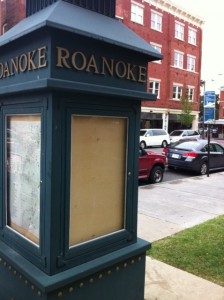
Downtown Roanoke’s historic center is just the beginning of what the area has to offer visitors. Photo by Clark Norton
Last week I spent several days in and around Roanoke, Virginia, hosted by the Roanoke Valley Convention & Visitors Bureau. The bureau brought in 19 travel writers and photographers from around the U.S. and Canada to discover what the area had to offer and, ideally, to write about it.
This is smart marketing. Publications large and small in states and provinces as diverse as California and Massachusetts, Colorado and Connecticut, Alberta and Ontario will carry travel articles about the Roanoke region that otherwise would never appear (most of the writers had never been there before). Some of the journalists were baby boomers, others were younger or older, so they’ll chronicle the destination from a variety of perspectives.
The press trip was organized by Geiger and Associates, a Tallahassee, Florida-based public relations firm that has these kinds of trips down to a science. Rather than try to herd all the writers around to all the same spots at the same times, which would be a counter-productive nightmare, Geiger representatives took smaller groups of writers around in vans to experience everything from driving the nearby Blue Ridge Parkway to exploring small historic towns, kayaking the James River, hiking the Appalachian Trail and sampling the wares at local wineries, among many other activities.
We were also accompanied by public relations people from the Roanoke Valley C&VB, who were able to provide local perspective, and sometimes by local guides and tour operators as well.
It’s a great way for the entire region — which uses the tagline “Virginia’s Blue Ridge” — to present what it has to offer. The writers get to choose which activities they want to pursue, so if someone isn’t interested in wine-tasting but loves history, or isn’t up for a long hike but would welcome a scenic drive, they are able to get the most out of their time spent.
And lest you think travel writing is all fun and relaxation, consider that days begin early and usually end late. One stalwart (bionic?) writer capped a long day of activities and interviews with a Roanoke opera presentation of Mozart’s The Magic Flute, which finished after 11 p.m., and began the next day with a bird-watching trip at 6:45 a.m., followed by a rugged eight-mile hike up and down a mountain, and, later, a bike ride. She had five minutes back at her hotel to splash some water on her face before dinner, and wasn’t sure when she’d have time to pack for her 5 a.m. pickup for the airport the next morning. But she was still considering the possibility of attending live music at a festival after dinner.
Not that she — or any of us — were complaining. We’re privileged to do what we do, and thankful to our hosts, who, in this case, displayed plenty of southern hospitality. Few of us who are freelancers can afford to pay all our own travel expenses and still make a living, so we depend on the kindness of strangers who soon become friends.
But, certainly in the case of most hard-working travel writers, we’re not so thankful that we’d write things about a destination that aren’t true. Magazines and newspapers that pride themselves on “truth in travel” because they don’t take stories from sponsored trips are fooling themselves and the public as well. My experience has been that all writers — whether on sponsored trips or not — are governed by their own sets of ethics and (not in any small part) by what their editors and readers want as well. Who pays for the trip is largely irrelevant (if publications pay expenses, great — but most don’t).
If the writer is a true professional, and their editors and readers value truth in travel, that’s exactly what they’ll get. Some editors, it’s sad to say, don’t want anything negative to appear in travel stories to avoid offending advertisers or turning off readers, so they’ll delete the “offending” parts. That’s not the writer’s fault.
In the end, travel writers have nothing but our credibility as journalists to market. And if we’re caught puffing up a place that doesn’t deserve it, we’ll be found out soon enough by justifiably angry readers.
Regular readers of this blog know that I dish out criticism as well as praise to those in the travel industry who I think are doing right, or wrong, by baby boomer travelers. As my own editor, I can promise you that I’ll continue to do just that.
And yes, I did like Roanoke and surroundings, so my next few posts will lay out exactly what I found that I think baby boomer travelers will enjoy.
Next up: Ten Things I Didn’t Know About Roanoke.












4 Responses to Virginia’s Roanoke Valley: Smart Marketing, Lots to Offer